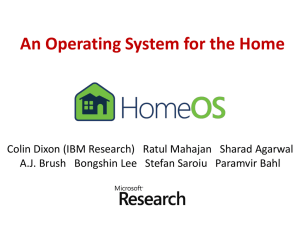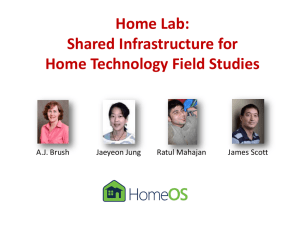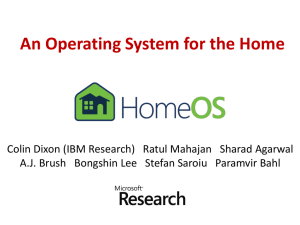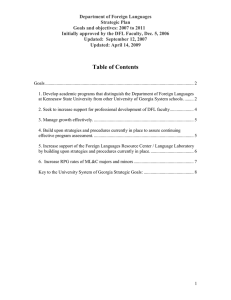Towards commodity smarthomes
advertisement
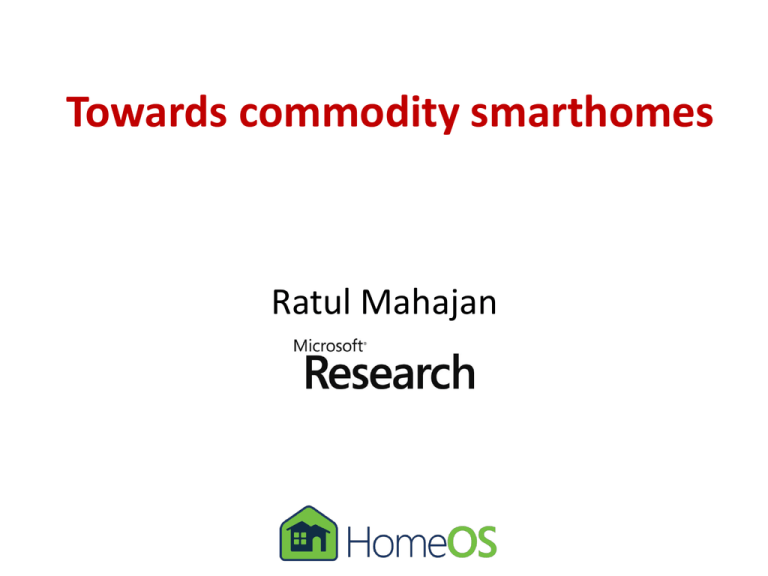
Towards commodity smarthomes
Ratul Mahajan
Partners in crime
A.J. Brush
Sharad Agarwal
Colin Dixon
Frank Martinez
Bongshin Lee
Stefan Saroiu
Smarthomes
Ability to automate and control multiple,
disparate systems within the home [ABI Research]
Status of smarthome technology
Envisioned by many researchers and companies
Struggling to break into the mainstream
– Despite commercial availability since 1970s
Talk outline
What explains the gap?
What really explains the gap?
How to bridge the gap?
Study to understand the gap
Visited homes with modern automation systems
Interviewed 31 people across 14 homes
Inventory
Semi-Structured
Interview
Questionnaire
Home Tour
[Home automation in the wild: Challenges and opportunities, CHI 2011]
How smarthomes?
DIY (do-it-yourself)
Outsource
$200 - $60k
Median: $5k
$14k – $120k
Median: $40K
Why smarthomes?
Convenience
“It allows me to be lazy”
Peace of mind
Control
Why not smarthomes?
Barriers to mainstream adoption
Hardware
inflexibility
Poor
extensibility
Management
nightmare
Adding tasks
Access control
or
Adding devices
Talk outline
What explains the gap?
What really explains the gap?
How to bridge the gap?
The home computing environment
Tasks
(software)
Devices
(hardware)
Energy
monitoring
Video
recording
Climate
control
Keyless
entry
Remote
lock
Users are not technically savvy
Extreme heterogeneity across homes
25
• Tasks
Have
20
• Devices
15
10
• Topology
5
• Control,
0
coordination
Control
Media
Security
Adjust windows, shades
Presence based devices
House energy monitor
Learning thermostat
View child PC use on TV
Buy
Limit time across devices
Log device usage
Remotely open locks
Automatic alerts
Remote camera access
Transfer video calls
Phone content -> TV
PC content -> phone
DVR content -> any TV
PC content -> TV
Centralized control
Set scenes
Key characteristics of the environment
Not
Environment
Prevalent abstractions for
organizing home technology
Network of devices
=> Interoperability protocols
• DLNA, Z-Wave, Speakeasy, …..
Closed, complete systems
=> Vertical integration
• Crestron, Control4, EasyLiving, …
Remote
monitoring
Climate
control
Interop alone leaves too much for users
Video
Recording
Climate
Control
CameraRemote
Based
Lock
Entry
No systematic manner to add tasks
Does not handle management and security
Vertical integration limits extensibility
Energy
monitoring
Video
recording
Climate
control
Keyless
entry
Remote
lock
Keyless
entry
Climate
control
Video
recording
Storage,
printing
Talk outline
What explains the gap?
What really explains the gap?
How to bridge the gap?
Our abstraction
View the home as a computer
• Networked devices =~ peripherals
• Tasks over these devices =~ applications
• Adding devices =~ adding a peripheral
• Adding tasks =~ installing an application
• Managing networked devices =~ managing files
[The home needs an operating system (and an app store), HotNets 2010]
HomeOS: An OS for the home
HomeStore
Video
Rec.
Remote
Unlock
Climate
HomeOS
Z-Wave, DLNA,
WiFi, etc.
HomeOS logically
centralizes all
devices
Users interact with
HomeOS, not
individual devices
HomeStore helps
find compatible
devices and apps
Goals of HomeOS
Easy to manage and
secure by non-experts
Mgmt. primitives align
with users’ mental models
Simplified application
development
APIs are protocolindependent services
Rapid inclusion of new
devices and features
Kernel is agnostic of device
functionalities
HomeOS layering model
Application layer
Tasks
Management layer
Control, coordination
Device functionality layer
Device
Device connectivity layer
Topological
Heterogeneity source
handled
DCL and DFL
DCL provides basic connectivity to devices
DFL exports device functionality as a service
DFL
DCL
– Services are protocol-independent
– Identified using roles and operations
Dimmer
MediaRenderer
Set(level)
Play(uri)
Get*() level PlayAt(uri, time)
Stop()
Status*() uri, time
PTZ Camera
GetImage*() bitmap
Up(), Down()
Left(), Right()
ZoomIn(), ZoomOut()
DCL and DFL: Reflections
Device interaction is split across two layers
– Allows smaller modules, avoids functionality duplication
Functional specs are more stable than device protocols
– Allows independent evolution of protocols and apps
DFL modules can export multiple roles for a device
– Allows easy extensibility along with backward compatibility
Management layer: Requirements
Time-based
access control
Apps as security
principals
Easy-to-understand
settings
Management layer: Primitives
Access control policy
as Datalog rules
[device, user group, app,
tstart, tend, dayOfWeek,
priority, accessMode]
Time-based
user accounts
Hierarchical user,
device groups
Application layer
Apps consume and compose DFL services
Manifests help with testing compatibility
– Lists of mandatory and optional requirements
– E.g., mandatory: {TV, SonyTV}, {MediaServer}
optional: {Speaker}
Implementation overview
Component-based OS
Uses C# and .NET
Evaluating HomeOS
Key questions:
• Can non-technical users manage HomeOS?
• Can developers easily write apps and drivers?
Method:
• Field experiences
• Controlled experiments
Field experience with HomeOS
12 homes running HomeOS for 4-8 months
– Using different devices and applications
• E.g., Cameras, light controllers, door-window sensors
41 student developers across 10 research groups
– Developed new drivers and apps
• E.g., energy meters, IM, appliance controllers
Example applications
For videos, see
http://research.microsoft.com/homeos/
Field experience: The good
Users could manage their HomeOS deployments
Users particularly liked the ability to organically
extend their technology
Developers found the programming abstractions
and layering to be “natural”
Field experience: The bad
Users found it hard to diagnose faults
Interoperability protocols can be fragile
Not all device features may be exposed over the
network
Results from controlled studies
10 developers asked to write a realistic app
– 8 finished in under 2 hours
12 non-technical users given 7 mgmt. tasks w/o training
– 77% completion rate; 89% after removing an outlier task
System can support interactive apps and large homes
Ongoing work
Predictable control
through fast forwarding
Sensor data privacy and
neighborhood watch
Conclusions
Extensibility and management hurdles are
keeping smarthomes out of mainstream
Organize home technology as a computer
HomeOS is one way to realize this organization
